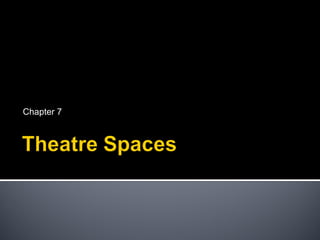Contenu connexe Plus de ProfessorGraham (9) 2. © 2013 The McGraw-Hill Companies, Inc. All Rights Reserved. 2
3. © 2013 The McGraw-Hill Companies, Inc. All Rights Reserved. 3
4. © 2013 The McGraw-Hill Companies, Inc. All Rights Reserved. 4
5. The audience faces in one direction, as in
a movie theatre
The action onstage is seen through a
frame of some kind
Proscenium comes from proscenium arch
—the frame that separates the stage from
the auditorium and forms an outline for
the stage
© 2013 The McGraw-Hill Companies, Inc. All Rights Reserved. 5
6. Proscenium features:
Fourth-wall convention
Rake
Orchestra
Fly loft
Ideal
for spectacles because the
machinery and the workings of the scene
changes can be concealed behind the
proscenium opening
© 2013 The McGraw-Hill Companies, Inc. All Rights Reserved. 6
7. Other advantages:
Effective for realistic settings
Strong central focus rivets attention of
audience
Disadvantages:
Creates a temptation to get carried away with
visual pyrotechnics
Tends to be remote and formal
© 2013 The McGraw-Hill Companies, Inc. All Rights Reserved. 7
8. © 2013 The McGraw-Hill Companies, Inc. All Rights Reserved. 8
9. Most widely used of all theatre spaces
The audience sits on three sides, or in a
semicircle, enclosing a stage that projects
into the center
Types of stages
Platform
Wagon
Corral
© 2013 The McGraw-Hill Companies, Inc. All Rights Reserved. 9
10. Offers a sense of intimacy
The rear wall of the stage provides a
focused background for the action
© 2013 The McGraw-Hill Companies, Inc. All Rights Reserved. 10
11. © 2013 The McGraw-Hill Companies, Inc. All Rights Reserved. 11
12. Also called circle theatre or
theatre-in-the-round
Has a playing space
in the center of a
square or circle,
with seats for
spectators
surrounding it
© 2013 The McGraw-Hill Companies, Inc. All Rights Reserved. 12
13. © 2013 The McGraw-Hill Companies, Inc. All Rights Reserved. 13
14. Advantages:
Offers intimacy
Allows for unconscious communication that is
created when people form a circle
Any large room can be converted into this
arrangement
© 2013 The McGraw-Hill Companies, Inc. All Rights Reserved. 14
15. Anevent such as a game in a sports
arena has a number of similarities to a
theatrical event
© 2013 The McGraw-Hill Companies, Inc. All Rights Reserved. 15
16. A theatre set up in a space not ordinarily
used for performance
All early theatres probably began this way
© 2013 The McGraw-Hill Companies, Inc. All Rights Reserved. 16
17. Street theatre
Brings performances
to places where people
do not normally attend
traditional theatre
© 2013 The McGraw-Hill Companies, Inc. All Rights Reserved. 17
18. Morethan one playing area where
something is going on simultaneously in
each area
Sort of like a three-ring circus
More like everyday life
No single space or activity is more important
than any other
Multimedia theatre
© 2013 The McGraw-Hill Companies, Inc. All Rights Reserved. 18
19. © 2013 The McGraw-Hill Companies, Inc. All Rights Reserved. 19
20. Can be adapted to an almost infinite
range of configurations
Sometimes referred to as black boxes
Every aspect—seats, lights, platforms,
levels—is flexible and movable
Aesthetic distance can be adjusted for each
production’s need
© 2013 The McGraw-Hill Companies, Inc. All Rights Reserved. 20
